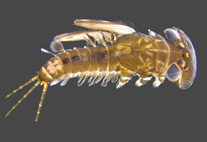Abstract
The megophryid frogs Leptobrachella brevicrus, Leptolalax dringi and Megophrys dringi are species exclusively known from highly localised areas in isolated mountain ranges on Borneo. The tadpoles and adults in this study were collected at the shared type locality for the three species in Gunung Mulu National Park, Sarawak, Malaysia (Borneo). The species identities of larvae were determined via comparison to syntopic adults using DNA barcoding techniques based on partial 16S rRNA mitochondrial gene sequences. The genetic data supported the status of the three taxa as valid species. Descriptions of colouration in life and after preservation, external morphological features, morphometric measurements and ecological notes in comparison to congeneric species are supplied. The tadpoles of L. brevicrus and L. dringi show similar adaptations to a fossorial lifestyle. These include an elongated, vermiform body, a relatively long tail and small eyes. Both were found in the gravel beds of a small mountain stream. In contrast, the larvae of M. dringi are adapted to occupying and feeding at the surface of pools within the stream.

